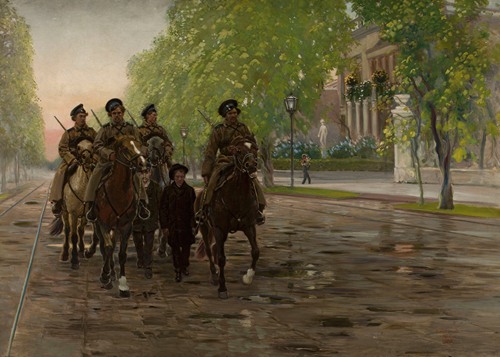
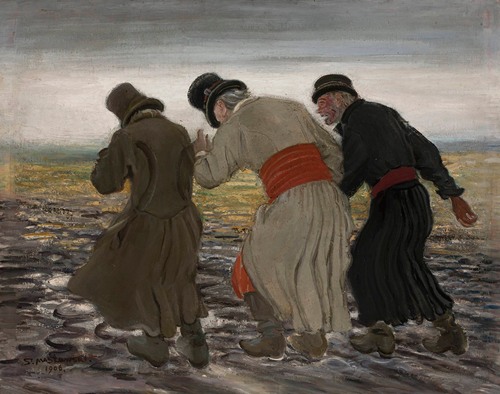
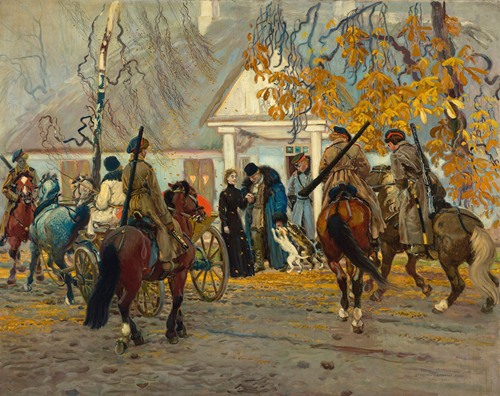
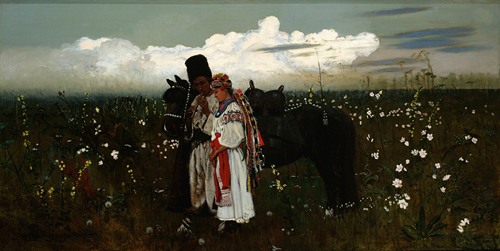
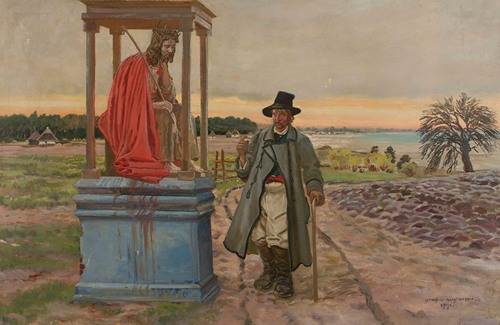
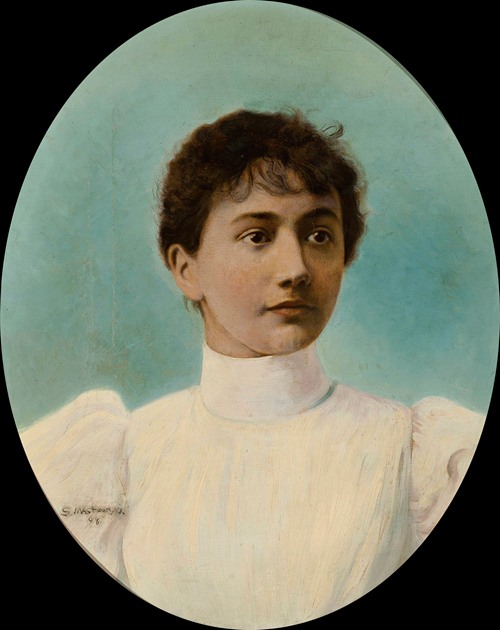
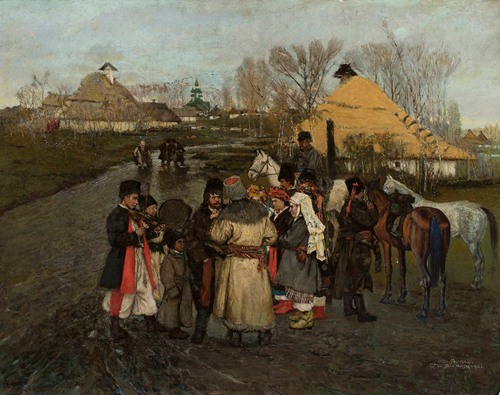
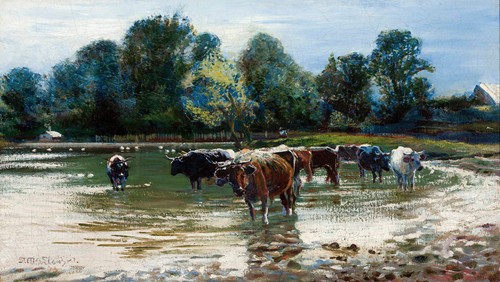
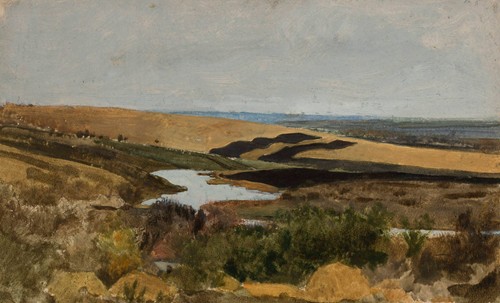

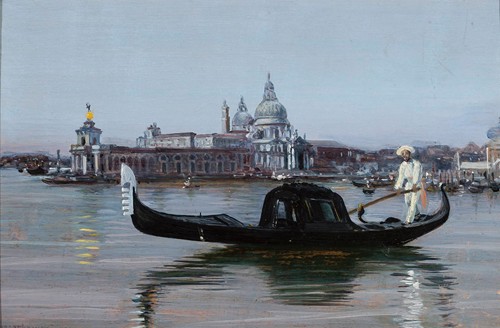
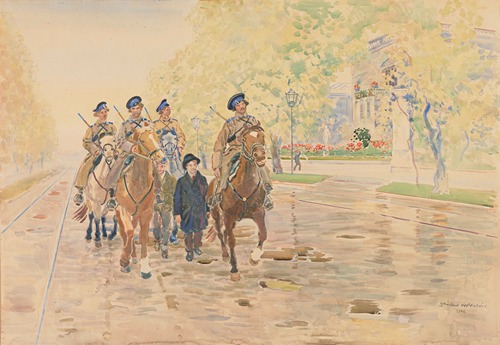
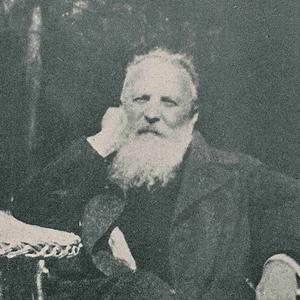

Stanisław Masłowski, born Stanisław Stefan Zygmunt Ludgard Masłowski was a Polish painter of realistic style, the author of watercolor landscapes.
Masłowski was born on 3 December 1853 in Włodawa on the Bug River (present day Poland), and there was christened 8 May 1854. His certificate of baptism is stored in the archives of the Parish of St. Louis of Pauline Fathers in Włodawa. He came from an impoverished noble family (Samson coat of arms), which originates from Wieluń (Poland) . "Masłowski" family used the nickname "Watta of Ruda" (Polish: "z Rudy"). Zygmunt Gloger in his Geografia historyczna ziem dawnej Polski (Historic Geography of Ancient Polish Lands) repeats after Jan Długosz, that the first capital of Wieluń County was Ruda before Wieluń, which was more conveniently located. Masłowski was the son of Rajmund Masłowski (1825–1897) and Waleria Józefa Katarzyna née Danilewicz (1827-1869). One of his four brothers was Bolesław Masłowski, chemist (1851–1928). Masłowski's grandfather from his mother, Wincenty Danilewicz vel Danielewicz, (Ostoja coat of arms, born in 1787 in Mińsk Lit. – former Polish–Lithuanian Commonwealth territory), was involved – as light-cavalryman – in the Napoleonic campaign, for which he was awarded the French Order of Legion of Honour. Masłowski's father was a lawyer. He was promoted several times, changing with his family place of residence.
Włodawa, place of birth of the future artist – was one of many towns where his father was employed. Masłowski family moved in 1856 from Włodawa to Garwolin, where Rajmund served as a courtroom writer. In 1858–1865 Maslowski lived in Chęciny. It is worth noting that Rajmund Masłowski in January Uprising was the head of the Chęciny district. Therefore, in mid- 1864 he was arrested, and then about six months he spent in prison in Kielce
Since 1865 Masłowski lived in Kalisz, where his first drawing teacher in the local high school, was painter Stanisław Barcikowski, a graduate of Warsaw School of Fine Arts. During this period, Masłowski drew a lot from nature, including between 1865 and 1871 in Bronów near Poddębice at his father's friends – Maria and Jarosław Konopnicki (see story by Konopnicka: "How do Children in Bronów with Rozalia Entertained", where he was called "Stasikoszczok") and then in Jędrzejów, where lived Wincenty Danilewicz, his grandfather. He was also copying Juliusz Kossak's pictures from illustrated magazines.
Since 1871 Stanisław Masłowski lived in Warsaw, where his father was transferred by court administration. His studies at the Warsaw School of Drawing (i. e. Wojciech Gerson's drawing school) lasted perhaps permanently in 1871–1875. "In this school I received – finds the artist in an autobiographical note – the advice of Mr. Gerson and Mr. Aleksander Kamiński." In 1875 Masłowski received the silver medal of the Academy of Fine Arts in St. Petersburg, as an award for his school drawings. During this period he took an active part in the life of the famous atelier rented by a group of artists-painters: J. Chełmoński, S. Witkiewicz, A.Piotrowski and others in the "Hotel Europejski" in Warsaw. Sincere affection for his colleagues from "Europe" (as he called it) remained him for the rest of his life.
However it was Ukraine, which gave to young Masłowski many painting emotions. For the first time he went there accompanied by writer Edward Chłopicki (1875). The second trip took place in 1876 (with this Ukrainian visit a number of Masłowski's letters to the artist-painter Władysław Leszczyński are involved). The next trips took place at least in 1878, and 1886.
In 1884–1887 Stanisław Masłowski entered a new phase of creativity and a new environment. At that time, he developed close relations with the group of friendly painters and writers associated with "Wędrowiec" weekly magazine, including Aleksander Gierymski and Antoni Sygietyński, and young painters: Józef Pankiewicz and Władysław Podkowiński. In 1886 Masłowski spent half a year in Munich, where – as he writes – "worked at home".
In Masłowski's creativity, years 1890–1907, was called a period of "the storm and ferment". Its initial phase is characterized by transition through impressionism and get away from it to find his own form. In 1897 Stanisław Masłowski became a member of the Society of Polish Artists "Sztuka" in Kraków, created at the initiative of Jan Stanisławski. A number of artists came from Warsaw e. g.: Józef Pankiewicz and Konstanty Laszczka. In 1899 Masłowski issued a number of watercolours in Aleksander Krywult Salon; this year and in 1902 he took part in the exhibitions of the Vienna Secession. In 1900 he traveled to Italy and Paris. In 1900 at the Universal Exhibition in Paris, he gained a medal award for picture "The market in the Kazimierz". In 1901 he demonstrated a small watercolours in the "Chimera" monthly editorial. Collective exhibition in 1902 in the Zachęta ends the second phase of Masłowski's creative explorations.
The restless period of 1902–1907 points out the artist's first trip in 1903 to Wola Rafałowska between Mińsk Mazowiecki and Siedlce, where he soon found his synthesis of his Polish landscape. In the following year he began a series of trips to Italy. In 1904 – to Rome, Florence, Fiesole, but also to Troki near Wilno. The special exhibition on "Zachęta" (1904) demonstrated Masłowski's 58 water-colours.
In 1905–1907 Masłowski worked in his atelier in Warsaw (at Mokotowska street) and experimented. Period of 1907–1926 was a phase of prosperity and decline of Masłowski's creativity. Plein air in Nowosiółka in Volhynia in 1908 brought 18 watercolours, which then was exhibited in the Society for the Encouragement of Fine Arts (Polish abbr.: TZSP). In 1909 and 1910 Masłowski had a solo exhibition there, and then exhibited there annually until 1914 the landscapes from Italy, Tunisia and from Polish village Wola Rafałowska. In 1913 Masłowski arranged a small exhibition of watercolours in the Galerie Léon Marseille in Paris.
In June 1914 Masłowski received an invitation to taking a position as professor at the Warsaw School of Fine Arts. However he not accepted the proposition. The outbreak of the World War I found him in the country. In April 1916 the Society for the Encouragement of Fine Arts arranged Masłowski's big collective exhibition. In December of that year he received the jubilee award of Society for the Encouragement of Fine Arts. The end of the war in 1918, brought great moral relaxation. Maslowski then painted a picture "Beliniacy" (related to name of one of Polish patriotic military divisions).
In 1921 Masłowski was elected a member of the Société Nationale des Beaux-Arts in Paris. In 1922 he made another trip to Italy. In 1925 a jubilee exhibition of Masłowski's works was held in the Society for the Encouragement of Fine Arts. The next year, Society for the Encouragement of Fine Arts issued a premium reproduction of his painting "Jarema's Duma" (of 1879). In 1925 Masłowski was awarded Officer's Cross of Polonia Restituta.
In the last year of life, suffering from a heart disease, he little worked. He died 31 May 1926 in Warsaw and was buried at the Powązki Cemetery in Warsaw, in the tomb of his mother's family (section 11-1-7/8, cf. the information boards behind the entrance of the "Saint Honorata" gate in the category: "Plastycy", i. e. "Artists").
A free time Maslowski was spending on your favorite readings of both the Old Polish literature, and foreign – mostly French or Italian (his favorite reading was Montaigne's writings – the book found by the bed after his death). A peculiar fruit of his reading was a translation into Polish of Giorgio Vasari's "Lives of the Most Eminent Painters, Sculptors, and Architects" (probably for the first time before World War I)
He was married (from 20 February 1897) to Aniela Ponikowska – sister of Cezary Ponikowski, lawyer (advocate-attorney), the first President of the Supreme Advocates Council in Poland (after restore of the independence of Poland, in 1918). They had son Maciej Masłowski, an art historian (born in Warsaw 24 January 1901, died in Wysokie Mazowieckie 17 August 1976).











